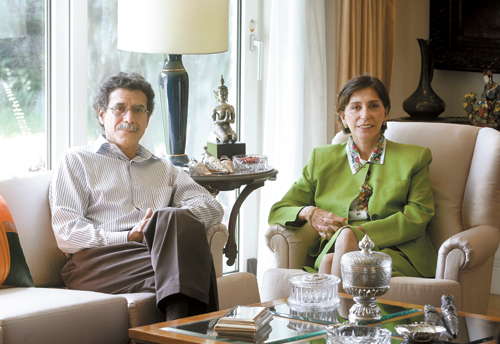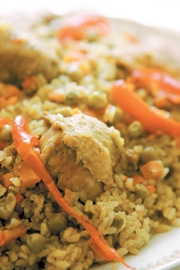In Peruvian food, it’s all in the mix

Peruvian Ambassador to Seoul Marcela Lopez Bravo, right, and her husband, Diego Del Risco. By Jeong Chi-ho
Peruvian cuisine arrived on the world scene on the back of its diverse ethnic population and the immigrants that have settled in the country in the past century. It’s a mixture of traditional dishes with contributions from all of these immigrant groups. We’re talking about Chinese, Spanish, Italian, French, British, Japanese and of course ancient Incan influences at play here. Add to that the climatic diversity of the country, and Peruvian cuisine displays a mix of flavors that is hard to find elsewhere.

Alfajores
The main dish was aji de gallina, or chili chicken stew. The tender chicken bites served with rice were an absolute treat for my taste buds. It was a hearty dish that was simple but carried enough weight to fill my stomach in a very pleasant way. It was accompanied by a dish called causa, a mix of mashed potato, lemon and tuna.

Rice with chicken
Pisco varieties are defined by flavor and the various forms of grapes used to make them, such as non-aromatic grapes, aromatic grapes, distilled grapes, or distilled grapes that have yet to be fully fermented.
When I did my research it became clear that I was dealing with a rising star in the culinary world.
On its Web site, the Peru Tourism Bureau quotes Patrick Martin, the academic director of the Paris, France-based culinary school Le Cordon Bleu, as saying: “One of the reasons why we have a school here is the excellent quality of the Peruvian cuisine, which I love.”
Like Martin, I knew I was on to something when I had my first taste of the cuisine.
As I have often discovered in the past, the dessert was one of the highlights of the meal. Alfajores is a common pastry in Peru that comes in different varieties. It is baked in an oven and consists of two layers of baked pastry with sweet and creamy fillings. Imagine a very soft caramel candy surrounded by a light, flaky pastry. And the taste? Ah yes, the taste. It’s still hard to articulate. I don’t want to use a single word such as “sweet” to describe my experience because I feel like doing so wouldn’t do it justice. Instead I’ll use a moaning sound: “Ahhhhhhhhh.?.?.”
Google “Peruvian cuisine” and you’ll be surprised at the rich array of colors that the dishes display. This is what eye candy is supposed to be. I have seen and tasted many international dishes (30 and counting) but it’s not often that I come across this sort of colorful display - and to discover it only now is actually quite a shocker. It proves you really do need all five senses to appreciate the things you have.
“Right now, Lima is the capital of Latin America’s culinary arts,” asserts Ambassador Lopez Bravo, who explains that the international success of Peruvian chef Gaston Acurio has catapulted the country’s cuisine to the forefront of the culinary world. “Our chefs now travel a lot to Europe to participate in festivals of gastronomy.”
Food aside, one thing I’ve noticed when making my rounds in the diplomatic community here is that many ambassadors from Latin American countries often point out the benefits that an improved relationship with South Korea could bring, even though the country’s foreign policy focus has yet to extend beyond its immediate neighbors and Washington. Ambassador Lopez Bravo was no exception.
“Koreans have looked to Latin America only in the last 20 years or so,” said the ambassador. “There was a lack of interest on both sides, but not anymore.”
As far as bilateral relations are concerned, inking a free trade deal is by far the most pressing issue for the Peruvian president, as he underlined last week. Following an agreement to discuss a free trade deal at the end of last year, four rounds of negotiations have been held since March. The trade balance is tipped slightly in favor of Peru. As of last year, South Korea’s exports to Peru were worth $720 million, while Peru’s imports to Korea were $903 million. In line with President Lee Myung-bak’s policy aim to diversify the country’s energy resources, Seoul has increasingly looked to Peru to make investments in mineral resources, petroleum, gas and other natural resources. Peru, meanwhile, is hoping to attract South Korean companies to its rich water resources and is promoting its hydroelectric power generation capacity.
But as far as I am concerned I only have one thing to say: Let the suits handle the business. Everyone else should seriously consider going on a food adventure to Peru. You are likely to find only pleasant surprises.
By Brian Lee [africanu@joongang.co.kr]










with the Korea JoongAng Daily
To write comments, please log in to one of the accounts.
Standards Board Policy (0/250자)